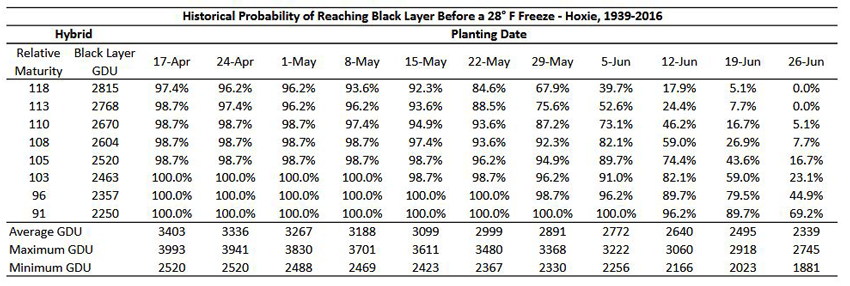Corn Maturity
NEW - Hybrid Maturity x Planting Date x Location Probabilities Based on Historical Weather Data
Late planting of corn: How location and hybrid maturity affect probability of success
While the precipitation received in western and central Kansas recently has been wonderful for filling the soil profile and thus has increased yield potentials, it has created significant delays in planting both irrigated and dryland corn. This late planting situation raises several considerations for producers, particularly hybrid selection with respect to maturity and potential crop insurance implications of late planting from a risk management standpoint.
Corn hybrid maturity
Many growers are familiar with corn hybrid maturity being expressed as days of "relative maturity" or RM. This system, in place for many years, has generally been more effective at comparing hybrid maturities within a company as opposed to across companies. Fortunately, in recent years many seed companies have started providing maturity information expressed as growing degree units (GDU's). Some companies provide both GDU's to silking and GDU's to maturity.
What is a GDU?
Growing degree units or growing degree days are a weather-based scale to measure the progression of crop phenology in thermally driven crops such as corn. GDD or GDU's are calculated as:
GDU = (Daily Maximum Air Temperature + Daily Minimum Air Temperature)/2 – 50
In the case of corn, when the maximum air temperature is greater than 86° F then the maximum air temperature is set to 86°, as the rate of growth for corn does not increase with increasing temperature above 86° F. Similarly, when the minimum air temperature is less than 50° F we use 50° as the value.
In general, it takes 90-120 GDU's for corn to emerge, residue and soil conditions contribute a great deal of variability to this range. A 110-day hybrid typically needs around 1500 GDU's to reach silking and 2670 GDU's to reach black layer or physiological maturity.
A "Growing Degree Day" calculator is now available on the Kansas Mesonet. This calculator will automatically figure the number of GDU's for corn (and other crops) at several locations across Kansas for any time period you'd like during the growing season. See: http://mesonet.k-state.edu/agriculture/degreedays/
Probabilities of corn reaching physiological maturity based on location, planting date, and hybrid maturity
Using historical weather data, the probability of reaching physiological maturity before a 28° F freeze can be calculated. The threshold of 28° F was used as long-term weather records only report the minimum, and not the duration of any given temperature. It takes multiple hours of 32° F to kill corn, but only a few minutes of temperatures at 28° F.
GDU's were totaled for each year from each of multiple planting dates to determine cumulative GDU's. This calculation was performed for 33 locations and 11 planting dates across western and central Kansas. GDU's to physiological maturity for a given relative maturity (in days) were determined by averaging the GDU's of a given relative maturity across multiple hybrids from multiple companies.
As an example, the probability table for Colby is shown below. This is based on weather records from 1900 through 2016. If we were to plant a 113-day hybrid on May 22nd, we see that the probability of reaching physiological maturity before a 28° freeze is 52.4%. Switching to a 108-day hybrid would improve that probability to 80%.

Local data is important in evaluating these probabilities as relatively short distances can result in large changes in probability of success for a given hybrid x planting date combination due to changes in elevation and rate of in-season accumulation of GDU's. For example, again looking at a 113-day hybrid planted on May 22nd, while the probability of black layer before a 28° freeze at Colby is only 52.4%, it is 91.3% at Hill City, 64 miles to the east, and 88.5% at Hoxie, a mere 33 miles to the east.

Probability charts for additional locations can be found at www.northwest.ksu.edu/agronomy.
It is important to note that these tables likely represent the "worst-case" scenario for probabilities of success. Data from the eastern Corn Belt suggest that when a hybrid is planted later than its optimal planting date it takes fewer GDU's to reach physiological maturity. Their data suggest that GDU requirements for maturity are reduced by 6.8 GDU's for every day that planting occurs after May 1st. Unfortunately, I have not been able to find data from the Great Plains to either confirm that rate or suggest another rate.
It's reasonable to believe that corn hybrids here will also reduce their GDU requirement with later planting. To get a full view of possibilities I would recommend you look at the probabilities for the maturity of the hybrid you are considering and then also the probabilities for a hybrid that is 3-6 day shorter. This will likely give you a realistic range of potential outcomes. For example, if you are considering the probabilities for a 110 day / 2670 GDU hybrid, you should consider the range of likely scenarios to be between the values listed for that hybrid and those listed for 108 or 105 day hybrid. So for a 110 day/2670 GUD hybrid planted May 29th at Hoxie, the range of probabilities would be 87.2 to 94.9%.
Click on the link titled NEW - Hybrid Maturity x Planting Date x Location Probabilities Based on Historical Weather Data near the top of the page.
Locations included in the analysis with tables that can be found at the link above include: Alton, Atwood, Belleville, Beloit, Bison, Brewster, Burr Oak, Cimarron, Colby, Concordia, Ellsworth, Garden City, Goodland, Hays, Hill City, Hoxie, Lakin, Leoti, Lincoln, Ness City, Norton, Oberlin, Phillipsburg, Plainville, Quinter, Russell Springs, Scott City, Sharon Springs, Smith Center, St. Francis, Syracuse, Tribune, and WaKeeney.
Lucas Haag, Northwest Area Crops and Soils Specialist, Colby
lhaag@ksu.edu